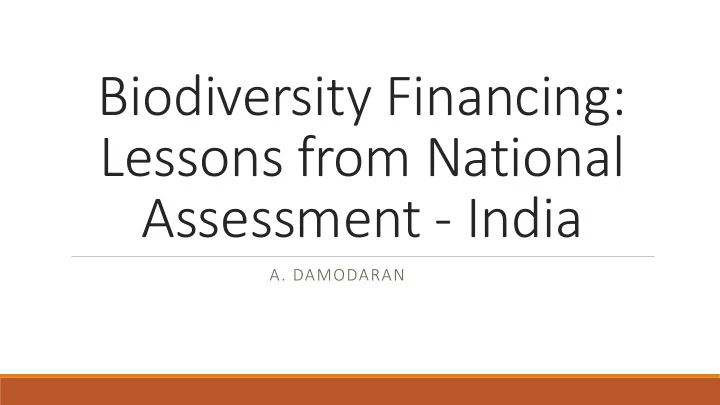

Biodiversity Financing: Lessons from National Assessment - India A. DAMODARAN
India: Annual Budget Figures in Dollar terms ( Source: Ministry of Environment, Forests and Climate Change,2014:India's Fifth National Report to the CBD *) Core = Rs 2000 crores ($0.44 billion) Non Core Leveragable = Rs 11,000 crores Total = Rs 13000 crores or $2.9 billion Non Core to core leverage ratio = 6.5 This can be leveraged through innovative re-design of development projects * (Hereafter also short referenced as MoEF and CC,2014)
Underlying Principles of Resource requirement assessment in Environment Sector History of ‘ aggregation based need assessment based on sectoral approaches Line Departments at the village and block/range /divisional levels prepare need assessments, which are aggregated at the Provincial levels and projected to Planning Authorities at the National level National level allocations tailor allocation of resources to availability of resources and possibility of achieving success in execution – ie capabilities as evident by physical progress achieved in the previous plan (the latter can be enhanced by GEF and other externally aided projects) In the case of development programs, there is evidence of local self government based plans which is aggregated upwards Either way there is an effort to co-relate needs as defined in physical terms with needs as defined in financial terms and also develop benchmarks of financial requirements per unit of ecosystem conserved (say ideal costs/ha for land treatment under Integrated watershed management Projects or on afforestation in per hectare terms)
Assessment Is a constrained assessment model depending on availability of financial resources We look at likely availability of resources and work on fulfillment of needs within these resource constraints We took core funding and non core funding We assume that non core funding require structural adjustments to tune it to Aichi targets which we related to global environmental benefits. This we assume to be the role of GEF and externally aided funds (TA, capacity building and technology leveraging) We divided Aichi targets into enabling ones, policy reform requiring and programmatic ones and postulated a flat 20% of total budget for the first type
Share of Core and Peripheral Annual Funding on Biodiversity Conservation (2010-11) Source : MoEF and CC (2014) Ministry of Environment & Forests: Rs. 2635.52 Crores (09.52 %) Ministry of Environment & Forests (Core) Leverageable Proportion Schemes of other Ministries relevant to Ministries Relevant to Biodiversity Conservation : Non- Biodiversity: Leverageable Rs. 25037.43 Crores (90.48 %) Schemes of other Ministries relevant to Biodiversity Conservation : Leverageable Source: http://indiabudget.nic.in
Share of Outlay on Biodiversity Relevant Schemes in the Aggregate Budget of Government of India during the year 2010-11 ; Source : MoEF and CC 2014 0.65 MoEF & Ministries Relevant to Biodiversity (Rs. 26312.95 Crores) Others (Rs. 3994858.26 Crores) 99.35 Source: http://indiabudget.nic.in
Percentage of Total Budget Spent by Various Ministries of Government of India (other than MoEF) on Biodiversity Relevant Schemes during the year 2010-11: Source: MoEF and CC 2014 0.72 Ministry of Rural Development 13.59 Ministry of Urban Development 2.57 0.31 Ministry of Earth Sciences Department of Agriculture 9.49 Department of Animal Husbandry 4.12 56.32 Indian Council of Agricultural Research (ICAR) Department of Ayurveda Yoga, naturopathy, Unani, Siddha and Homeopathy (AYUSH) Source: Annual Report of Ministries Concerned for 2010-11
Relative Shares of Central and State Governments in Core Annual Funding on Biodiversity Conservation during the year 2010-11 (in %) (Source:MoEF and CC 2014) 38.75 61.25 Government of India (Rs. 2429 Crores) Average Spending by States (Rs. 3840 Crores) Source: Annual Report of Ministry of Environment and Forests
India: Relative Allocation Profile ( Source: Ministry of Environment, Forests and Climate Change,2014:India's Fifth National Report to the CBD)
India: Biodiversity Conservation Funding by States (Source: Ministry of Environment, Forests and Climate Change,2014:India's Fifth National Report to the CBD) Core funding by States in 2013-14 INR 5025 crores 12 th Finance Commission (2005-2009) INR 1000 crores 13 th Finance Commission(2010-2014) INR 5000 crores
Multipliers Used to Establish Contribution of Peripheral Funding India: Multipliers Used (Source: Ministry of Environment, Forests and Climate Change,2014:India's Fifth National Report to the CBD)
Issues Strategic Goals - Aichi Target (nos) – National Biodiversity Action Plan (nos) – Schemes Indicators – Schemes correlation Core/Non Core and Peripheral – classify in terms of NBAP and corresponding Aichi Targets Multiplier Co-efficients – ‘Probability’ of Biodiversity Outcome based allocations / disbursements
Issues Funding Gap Assessment – Convert physical targets to potential Financial targets Difficult to assess ‘resource needs on mainstreaming’
The End
Recommend
More recommend